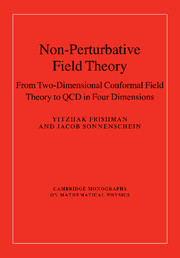Book contents
- Frontmatter
- Contents
- Preface
- Acknowledgements
- PART I NON-PERTURBATIVE METHODS IN TWO-DIMENSIONAL FIELD THEORY
- PART II TWO-DIMENSIONAL NON-PERTURBATIVE GAUGE DYNAMICS
- PART III FROM TWO TO FOUR DIMENSIONS
- 17 Conformal invariance in four-dimensional field theories and in QCD
- 18 Integrability in four-dimensional gauge dynamics
- 19 Large N methods in QCD4
- 20 From 2d bosonized baryons to 4d Skyrmions
- 21 From two-dimensional solitons to four-dimensional magnetic monopoles
- 22 Instantons of QCD
- 23 Summary, conclusions and outlook
- References
- Index
21 - From two-dimensional solitons to four-dimensional magnetic monopoles
Published online by Cambridge University Press: 07 September 2010
- Frontmatter
- Contents
- Preface
- Acknowledgements
- PART I NON-PERTURBATIVE METHODS IN TWO-DIMENSIONAL FIELD THEORY
- PART II TWO-DIMENSIONAL NON-PERTURBATIVE GAUGE DYNAMICS
- PART III FROM TWO TO FOUR DIMENSIONS
- 17 Conformal invariance in four-dimensional field theories and in QCD
- 18 Integrability in four-dimensional gauge dynamics
- 19 Large N methods in QCD4
- 20 From 2d bosonized baryons to 4d Skyrmions
- 21 From two-dimensional solitons to four-dimensional magnetic monopoles
- 22 Instantons of QCD
- 23 Summary, conclusions and outlook
- References
- Index
Summary
Introduction
Solitons play an important role in non-perturbative two-dimensional fields as we have seen in the first part of this book. They are intimately related to non-trivial topology, they are an essential ingredient in integrable models, and they enable the phenomenon of fermion boson duality-bosonization. When passing to four-dimensional field theories the topology may be even richer and thus we would anticipate having topological solitons as static solutions also in four-dimensional space-time. As we have seen in Section 5.3, Derrik's theorem does not permit the existence of solitons of scalar field theory in space dimensions higher than one, however, they are not prohibited in theories that include higher spin fields, in particular in theories of scalar fields coupled to non-abelian gauge fields. Indeed as we will see in this section certain theories of this type that admit spontaneous symmetry breaking, admit soliton solutions. These configurations carry a conserved topological charge which guarantees their stability against decay to the vacuum. As it will turn out this charge is in fact a magnetic charge and hence these solitons are magnetic monopoles, or in the more general case dyons with both magnetic and electric charge. The construction of dyons from static solutions will be the analog process of building up breathers from two-dimensional solitons.
- Type
- Chapter
- Information
- Non-Perturbative Field TheoryFrom Two Dimensional Conformal Field Theory to QCD in Four Dimensions, pp. 371 - 388Publisher: Cambridge University PressPrint publication year: 2010

